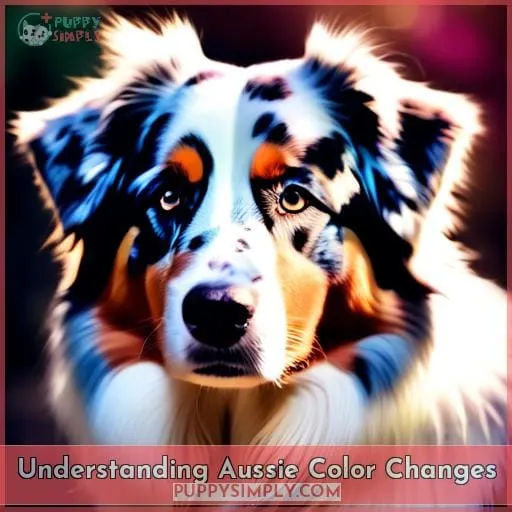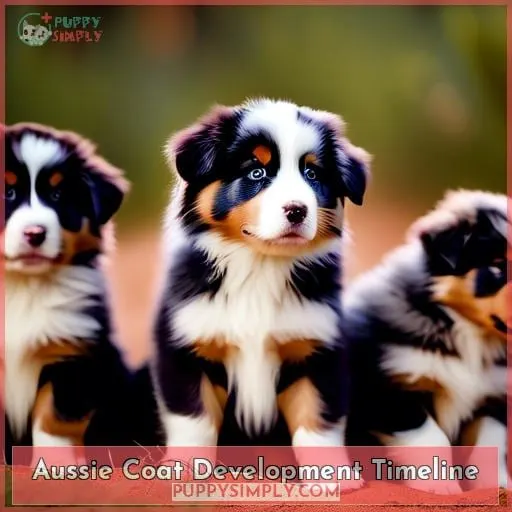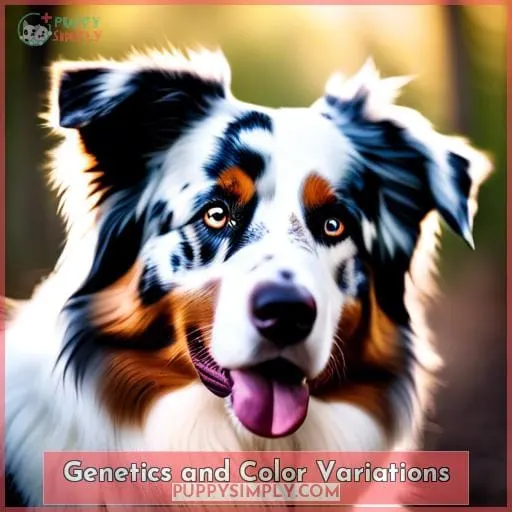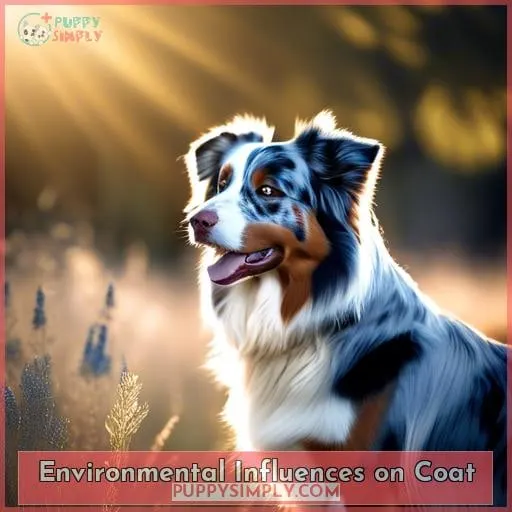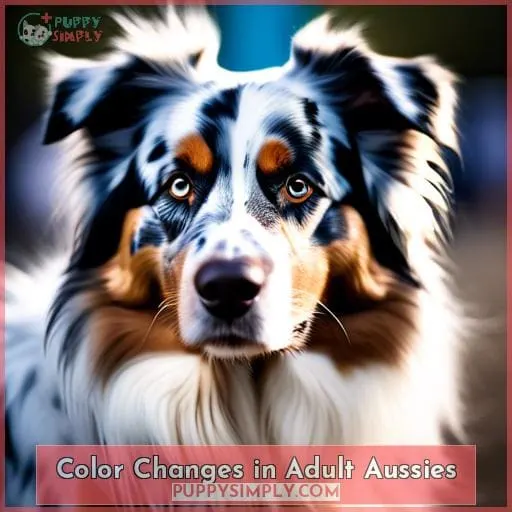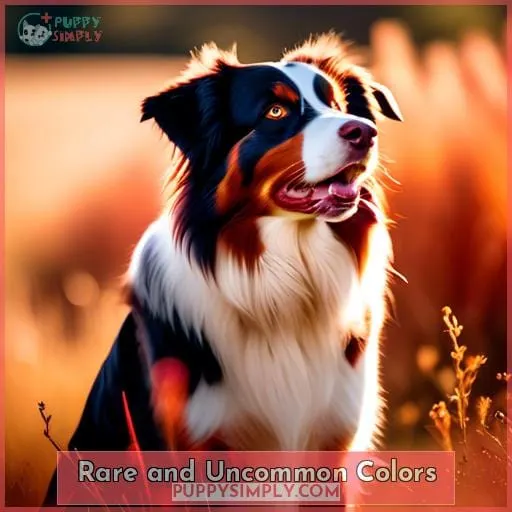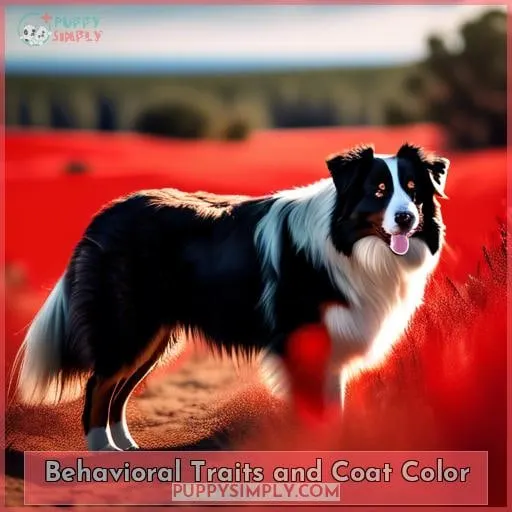This site is supported by our readers. We may earn a commission, at no cost to you, if you purchase through links.
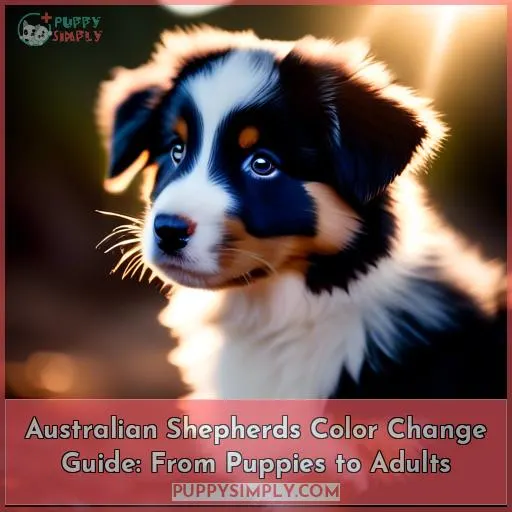
You’re about to dive into the fascinating world of Aussie color changes, where genetics play the lead role, and every gene tells a story of potential transformations.
Whether it’s the sun-kissed bleaching of reds or the mysterious darkening of merles, the coat of an Aussie is a living canvas, evolving with age, environment, and health.
This guide will unravel the secrets behind these changes, offering insights into the genetic dance that determines whether your Aussie will sport a coat of shifting shades or maintain its puppy palette into adulthood.
Table Of Contents
- Key Takeaways
- Understanding Aussie Color Changes
- Aussie Coat Development Timeline
- Genetics and Color Variations
- Environmental Influences on Coat
- Health and Nutrition Factors
- Grooming and Coat Maintenance
- Color Changes in Adult Aussies
- Rare and Uncommon Colors
- Behavioral Traits and Coat Color
- Frequently Asked Questions (FAQs)
- Do Australian Shepherds change eye color as puppies?
- What is the typical lifespan of an Australian Shepherd by coat color?
- Do Australian Shepherds with merle coats have more health issues?
- How often should Australian Shepherds be professionally groomed?
- Are some Australian Shepherd color patterns more rare or valued than others?
- Conclusion
Key Takeaways
- Coat color and texture changes from puppyhood to adulthood are common in the breed due to genetic factors, sun exposure, and the transition to adult coat.
- Merle Aussies can show more dramatic color changes over time due to complex genetic interactions influencing the merle coat pattern.
- Environmental factors like sun exposure can lighten coat color over time through bleaching and fading of rich pigment colors.
- Health and nutritional deficiencies may also lead to alterations in an Australian Shepherd’s coat coloration and appearance.
Understanding Aussie Color Changes
Australian Shepherds are known for their dynamic and often changing coat colors, which can range from black, blue merle, red, to red merle.
As your Aussie puppy, Tripp, transitions from puppyhood to adulthood, you might notice not just color changes but also variations in coat texture and length.
This transformation is a natural part of their development, influenced by genetics, sun exposure, and other factors.
Understanding these changes can help you appreciate the unique beauty and complexity of your Aussie’s coat as it evolves.
Puppy to Adult Transition
Many Australian Shepherd puppies, including your Tripp, undergo significant color changes as they transition from puppyhood to adulthood.
Witnessing the Transition Progression can be both fascinating and bewildering.
Changes in Coat Texture may accompany the color shifts, adding depth to their unique appearance.
Color Shifts reflect a complex genetic dance, revealing the artistry of nature.
Growth Patterns and Maturation Timeline vary, showcasing the breed’s diverse beauty.
Embrace this phase as your Aussie’s fur color change marks a milestone in their journey to becoming an adult Aussie.
Seasonal Variations
Australian Shepherds, known for their intelligence and striking appearance, undergo various changes in coat color and texture throughout their lives.
The color changes observed in Tripp, a 4-month-old blue merle Australian Shepherd, aren’t uncommon for the breed.
These changes can be attributed to several factors, including:
- Genetics
- Sun exposure
- The transition from puppy to adult coat
Aussie Coat Development Timeline
Australian Shepherds, like your puppy Tripp, undergo significant changes in their coat color, texture, and length as they mature.
The transition from a puppy coat to an adult coat typically begins around four to six months of age and can take several months to complete.
During this period, you may notice changes in the color and texture of Tripp’s coat.
The color changes you’re observing in Tripp aren’t uncommon in Australian Shepherds.
Some puppies experience significant color changes as they mature, with progressive darkening of merle areas being common.
Sun exposure can also cause temporary color changes, such as turning reds and red merles to a yellowish hue.
The timeline for these changes can vary.
On average, Australian Shepherds develop their full coats by the time they’re about two years old.
However, some dogs may have a full coat as early as one year old.
It’s important to note that the reasons for color changes in Australian Shepherds aren’t fully understood, but genetics, sun exposure, and aging may play a role.
If you notice any drastic or sudden changes in Tripp’s coat, it may be a good idea to consult a veterinarian, as it could indicate an underlying health issue.
In terms of care, regular grooming can help manage shedding and maintain the health and appearance of Tripp’s coat.
A balanced, nutritious diet can also promote a healthy coat.
Full Coat Maturation
Now, let’s delve into the timeline of your Aussie’s coat maturation, a process that can take several months and is influenced by various factors.
The journey from puppy fluff to the full, lustrous adult coat, known as full coat development, is a fascinating display of genetics at work.
This growth progression is marked by significant color transition and hair evolution, reflecting the unique genetic characteristics of Australian Shepherds.
Understanding this maturation timeline offers insight into the breed’s behavior and color variations, enriching your connection with your Aussie.
Factors Affecting Growth
Your Australian Shepherd Tripp’s color change from a blue merle to a redder hue, including a peach-colored head, isn’t an uncommon phenomenon in the breed.
Factors affecting growth and color changes in Australian Shepherds like Tripp include:
Genetics: Merle Aussies can show a range of color changes due to complex genetic interactions.
Health: Conditions like stress response or hormonal influences can alter coat appearance.
Environment:
- Dietary impact
- Exercise effects
- Sun exposure
All play roles in coat development.
Genetics and Color Variations
As you explore the world of Australian Shepherds, you’ll find that their coat colors are a complex interplay of genetics.
The merle pattern is particularly dynamic, influenced by a specific gene that can create a range of appearances, from subtle mottling to bold patches.
Understanding how recessive genes impact coat color will help you appreciate the breed’s diverse palette and predict potential changes as your Aussie grows.
Merle Color Dynamics
Understanding the merle color dynamics in Australian Shepherds involves delving into the genetics and color variations that make this breed so visually captivating.
The merle gene causes a mottling effect, creating patches of diluted pigment on a darker base, which can result in a stunning array of patterns and colors within the breed. This genetic trait is incompletely dominant, meaning that it expresses differently depending on whether a dog inherits one or two copies of the merle gene.
Single merles exhibit a more pronounced merle pattern, while double merles, having inherited the gene from both parents, show a much lighter coat, often with increased health risks such as deafness and vision problems.
The primary merle colors in Australian Shepherds are blue merle and red merle. Blue merles have a base of black, gray, and white, with the merle gene diluting the black to create a marbled effect. Red merles exhibit a similar pattern but with a base of red or liver color, leading to a lighter, peachy or orange hue where the dilution occurs.
These color variations aren’t just aesthetically pleasing; they also have implications for the dog’s health and breeding considerations. For example, breeding two merle dogs can result in double merles, which may suffer from severe health issues due to the homozygous state of the merle gene.
Environmental factors like sun exposure can also influence the appearance of a merle coat, potentially lightening the color further. Additionally, the coat of a merle Australian Shepherd can change over time, with puppies often experiencing shifts in color and pattern as they mature into their adult coats.
This transition can include changes in color intensity and pattern distribution, making the merle Australian Shepherd a breed of dynamic beauty and complexity.
Recessive Gene Impact
In exploring the intricate world of Australian Shepherd coat colors, one can’t
overlook the significant role recessive genes play in the myriad of variations observed.
Genetic Inheritance:
- Determines the potential for certain coat colors.
- Recessive alleles are often hidden in the genetic code.
Coat pigmentation:
- Can be drastically altered by these recessive genes.
- Affects the phenotypic expression in surprising ways.
Color variation:
- In Aussier is a complex tapestry,
- Woven from the interactions of dominant and recessive genetic factors.
Environmental Influences on Coat
As you spend time outdoors with your Australian Shepherd, it’s important to consider how the environment impacts their coat.
Sun bleaching is a notable effect, particularly for red and red merle Aussies, whose coats can lighten with extensive exposure to sunlight.
To maintain the vibrant color of your Aussie’s coat, managing their time in the sun and providing shade can help mitigate these changes.
Sun Bleaching Effects
Over time, your Aussie’s coat color can be lightened by exposure to sunlight.
This sun bleaching effect breaks down melanin pigment in the hair shaft, causing black or red coats to fade.
Extended time outdoors without protection can slowly turn your dog’s rich colors to a more washed out, muted version.
Using dog-safe sunscreen, keeping play sessions brief at peak sun hours, and providing shade can help prevent excessive sun damage.
Monitoring vitamin levels and diet is also key, as nutritional health impacts resistance to UV ray effects.
With some planning and care, you can help your Aussie retain his beautiful, vibrant coat.
Impact of Outdoor Activity
When spending considerable time outdoors, you’re risking sun bleaching and weathering of your Aussie’s coat.
As highly active dogs bred for outdoor work, Aussies love to explore and need sufficient exercise.
However, extensive sun exposure and physical activity can lighten coat color over time.
The UV rays break down pigment in the hair follicles, gradually fading the coat.
Additionally, burrs and debris accumulate more easily on a working coat.
To balance your Aussie’s innate needs and preserve coat quality, provide daily vigorous exercise along with grooming to remove foreign matter.
Rotate indoor and outdoor play times to moderate sun exposure.
With smart management of environmental factors, you can maintain the health and appearance of your Aussie’s beautiful coat.
Health and Nutrition Factors
You should also consider if nutritional deficiencies or underlying health conditions are affecting your Aussie’s coat.
Both can lead to changes in texture, color, or condition that may seem abnormal.
Checking with your vet can help determine if an illness is the cause of any unusual shifts you notice.
Nutritional Deficiencies
You’re risking coat color changes if your Aussie’s diet lacks certain vitamins and minerals.
A balanced diet supports healthy skin and a rich coat color.
Make sure your dog gets enough protein, fatty acids, zinc, copper, and vitamin E.
These nutrients influence melanin production and coat pigmentation.
Monitor your Aussie’s food intake and adjust as needed to maintain dietary balance.
Supplement when necessary to provide complete nutrition.
With proper nutrient intake, you can help minimize irregular coat color changes unrelated to normal genetics and development.
Consult your veterinarian if you notice significant variations in your dog’s coat despite a healthy diet.
Underlying Health Conditions
However, underlying health conditions like hormone imbalances or autoimmune diseases can also lead to dramatic coat changes in Aussies.
You’d want to have your vet run some tests if your pup’s coat takes on an unusual color or texture that doesn’t seem linked to normal shedding or sun exposure.
- Autoimmune Disorders
- Vitiligo
- Skin Infections
- Allergies
- Hormonal Imbalances
Grooming and Coat Maintenance
When it comes to your Aussie’s coat, regular brushing is key.
- Manage shedding and remove dead hair.
- Bathe your dog only when necessary, using gentle dog shampoos.
- Maintain the natural oils in their skin and coat.
Pay close attention to their skin and coat health, as changes can indicate potential health issues.
Brushing and Shedding
With regular brushing, you’re helping remove loose puppy fur during your Aussie’s heavy seasonal sheds.
Use a slicker brush to lift out the undercoat without irritating your pup’s sensitive skin.
Brush against the coat growth to lift and remove dead hair more easily.
Focus on body areas prone to matting like the legs, belly, and behind the ears.
Checking for mats while brushing allows you to gently work apart tangles before they tighten.
Schedule regular brushing sessions based on your pup’s shedding cycles.
Consistent fur care prevents painful mats and keeps their coat healthy.
Bathing and Skin Care
You bathe your Aussie once a month to maintain healthy skin and coat.
Use a gentle hypoallergenic shampoo formulated for dogs to cleanse dirt and debris without over-drying.
Check shampoo pH levels, as improper pH can disrupt skin barrier function.
Target bathing to meet individual lifestyle and activity levels.
Rinsing thoroughly prevents residue buildup.
Regular brushing stimulates natural oil production to properly hydrate fur.
Examine skin while bathing for abnormalities suggestive of underlying health conditions.
Moisturize as needed, focusing on areas prone to dryness.
Implementing smart bathing and moisturizing techniques promotes skin and coat health.
Color Changes in Adult Aussies
You may notice your Aussie’s coat progressively darken as they mature, especially merles, due to increased melanin production.
More concerning is if they rapidly develop depigmented patches of skin and fur, which could signal an autoimmune disorder like idiopathic vitiligo.
Let’s take a closer look at what might cause these adult color changes in our beloved pups.
Progressive Darkening
Having covered grooming and coat maintenance, you’re likely wondering if color changes can occur in adult dogs.
With some Aussies experiencing progressive darkening of their merle patterning over time:
- The reasons aren’t fully understood, but may involve increased melanin production as the dog ages.
- Blue merles may resemble black tris, while red merles resemble red tris or selfs.
- Harlequins can also fill in lighter fur areas with darker pigment over time.
While unusual, some Aussies experience vitiligo, losing pigment due to an autoimmune disorder.
If you notice progressive coat changes in your Aussie, consult your veterinarian.
Idiopathic Vitiligo
The cases of Cosmo and Nikki’s color changes illustrate how some adult Aussies develop idiopathic vitiligo.
This results in dramatic coat alterations including progressive whitening or textural shifts.
Idiopathic vitiligo in Aussies presents diagnosis challenges given the merle coat patterns.
Estimated prevalence is 1-2% in the breed.
Treatment options are limited but include nutritional supplementation and sun avoidance.
Coping strategies involve maintaining coat health and monitoring for secondary infections.
More research on prevalence and treatment is needed to better understand this perplexing adult-onset condition in certain bloodlines.
Rare and Uncommon Colors
Black and tan variants and yellow Aussies are rare coat colors for the breed.
Though uncommon, some Aussies carry recessive genes that produce these atypical shades.
Understanding the genetic basis helps breeders thoughtfully plan litters to preserve heritage colors.
Black and Tan Variants
You’ve seen Aussies in common colors like red merle and blue merle, but some rare black and tan variants exist with unique patterns and gene combinations.
The black and tan gene series interacts with other coat color genes resulting in unexpected expressions like red tans when combined with recessive red and tricolor genes.
Genetic linkage between coat color genes leads to patterns not fitting standard breed color expectations.
Recessive inheritance of certain alleles allows unexpected colors to appear occasionally.
Dominant expression of some interacting genes modifies base colors like black and tan overriding merle.
Yellow Aussies
While yellow coats are rare in Aussies, some dogs develop a golden or yellowish hue if their red coats fade significantly from sun exposure over time.
The genetic origins of a yellow coat likely stem from the e/e extension gene interacting with other coat color genes.
Although yellow coats deviate from the breed standard, no major health impacts have been linked to this variation yet.
Both nutritional causes like fatty acid deficiencies and sun exposure can contribute to coat fading.
While uncommon, yellow and faded red coats represent natural coat color variations in the breed.
Behavioral Traits and Coat Color
Unfortunately, some myths persist about links between coat color and temperament in Australian Shepherds.
However, research shows behavior arises from complex interactions between genetics and environment, not coat color alone.
We’ll clarify the current science on this issue.
Myths and Misconceptions
Despite assumptions, your Aussie’s temperament is not defined by their coat color.
Myths exist that certain colors like merle Aussies tend to be more aggressive or active.
Extensive research into coat color genetics reveals no correlation between an Aussie’s color pattern and their personality traits.
While the merle gene can impact health, it does not determine temperament.
We must dispel fallacies linking coat to behavior, as pups of all colors can exhibit the loyal companionship Aussies are cherished for.
Evaluating temperament based on individual personality better serves both dogs and owners.
Color and Temperament
Your dog’s coat color has no direct link to their personality or health.
However, some coat patterns like merle are associated with increased health risks that may impact behavior if vision or hearing is affected.
Responsible breeders select pairings to:
- Maximize genetic diversity
- Minimize doubling up on deleterious recessive genes
Understanding color genetics helps guide:
- Ethical breeding practices
Behavior is shaped by:
- Proper socialization
- Training from an early age
Activity levels and trainability are managed by:
- Outlets that are:
- Not based on assumptions
- Based on your dog’s needs
Focus on:
- Health
- Building a relationship
- Not coat color
Frequently Asked Questions (FAQs)
Do Australian Shepherds change eye color as puppies?
No, Australian Shepherds’ eye color is set by around eight weeks old.
Their eyes may appear to change hue slightly as puppies, but the adult eye color is established early on.
Genetics determine their eventual mature eye shade.
What is the typical lifespan of an Australian Shepherd by coat color?
Unfortunately, research hasn’t clearly established strong links between coat color and lifespan in Australian Shepherds.
Their typical lifespan ranges from 12-15 years on average, with proper care and nutrition playing a bigger role than coat genetics.
Maintaining a healthy lifestyle can help Aussies live happily within this range, regardless of their color.
Do Australian Shepherds with merle coats have more health issues?
Unfortunately, some merle Aussies may have slightly increased health risks due to their coat genetics.
Proper breeding selection helps minimize this.
We strive for healthy dogs above all else.
How often should Australian Shepherds be professionally groomed?
Australian Shepherds should be professionally groomed every 6-8 weeks.
This helps maintain their coats by removing dead hair and preventing mats.
Regular grooming also allows for health checks and strengthens the human-canine bond through positive handling.
Schedule appointments based on your Aussie’s individual needs.
Are some Australian Shepherd color patterns more rare or valued than others?
Yes, some patterns and colors like liver merles, lethals, harlequins, and blue or red tris tend to be more rare or valued among breeders and owners.
Their unique markings make them desirable.
Conclusion
Contrary to genetic prophecies, an Aussie’s chameleon coat often outsmarts scientific predictions.
While shifts from fluffy puppy fuzz to lustrous adult locks follow genetic scripts, the ever-changing palette of merles and sun-kissed reds scoffs at pedigree constraints.
Just when we think we’ve captured an Aussie’s true colors, their dazzling do [Australian shepherds] change color transformations remind us that beneath that shapely dome lies a creative spirit, painting new shades upon life’s canvas.

